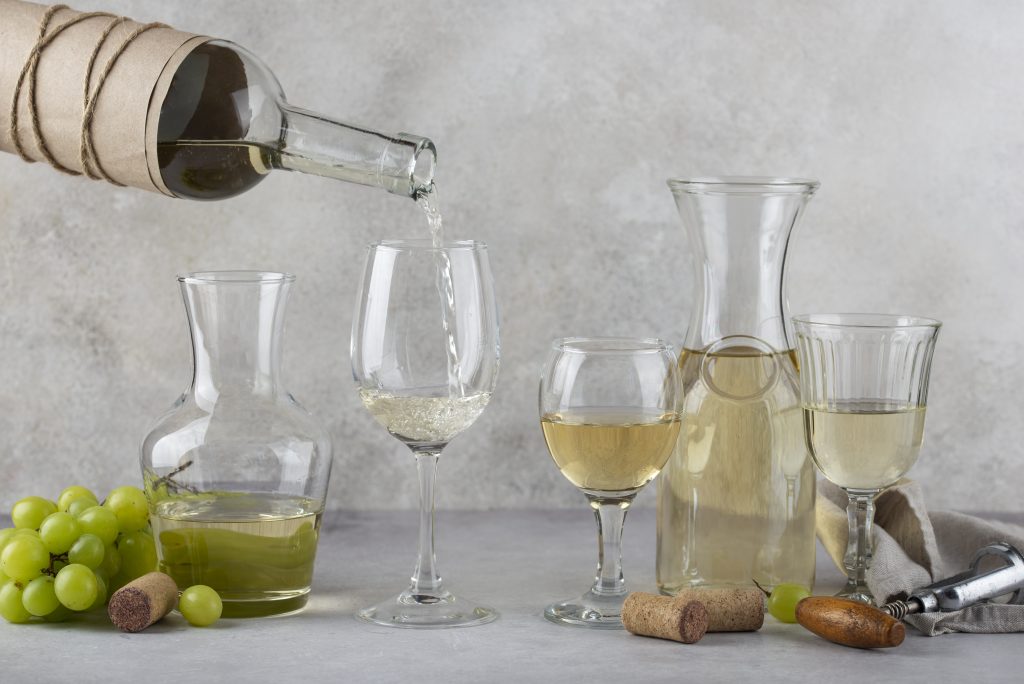Are you a passionate home cook eager to elevate your culinary creations? Look no further, we’re here to guide you through the world of cooking with white wine. In this article, we’ll compare three popular white wine varietals – Pinot Grigio, Chardonnay, and Sauvignon Blanc – to determine the best one for cooking. By exploring their flavors, acidity levels, and versatility, you’ll gain a deeper understanding of how each wine can enhance your dishes. So grab your apron, a glass of your favorite white wine, and let’s dive into the delicious world of cooking with Pinot Grigio, Chardonnay, and Sauvignon Blanc.
Contents
- Dry Vs Sweet: Understanding White Wine for Cooking
- Pinot Grigio: A Versatile Cooking Wine
- Chardonnay: Exploring Its Role in Cooking
- Sauvignon Blanc: The Perfect Wine for Seafood
- Dry Sherry: Enhancing Creamy Sauces and Appetizers
- Dry Marsala: Classic Pairings for Chicken and Veal
- Sparkling Wine and Dry Madeira: Surprising Alternatives for Cooking
- Substitutes and Storage: Making the Right Choices for Cooking
Dry Vs Sweet: Understanding White Wine for Cooking
When it comes to cooking with white wine, it is important to understand the difference between dry and sweet varieties. Dry white wine refers to any white wine that is not sweet. It has high acidity, which can balance out heavy cream sauces or provide a lemon-like flavor. Good choices for cooking include Pinot Grigio, Pinot Gris, Sauvignon Blanc, Pinot Blanc, and dry sparkling wines labeled brut. These wines are versatile and can be used in a variety of dishes.
Understanding acidity is key when choosing the right varietal for cooking. Crisp white wines with moderate alcohol content and acidity are ideal. Pinot Grigio is neutral and versatile, while Sauvignon Blanc adds racy acidity, perfect for seafood dishes or sauces with heavy cream. Unoaked Chardonnay contributes richness. It is important to avoid wines labeled as cooking wine and opt for dry, medium-bodied white wines.
Cooking with herbal whites can add amazing dimension to dishes. Sauvignon Blanc and Grüner Veltliner are herbal dry white wines suitable for cooking vegetables. They can be used with various dishes like artichoke, tomatoes, swiss chard, eggplant, garlic, bell peppers, and mushrooms. Adding a little butter and lemon can enhance the deliciousness and balance of acidity.
If you need to substitute for wine, dry vermouth can be used in most cases. Lemon juice or white wine vinegar can provide a splash of acidity. Dry sherry, Marsala, or Madeira can also be used as substitutes. White grape juice can add sweetness when deglazing a pan, while chicken or vegetable stock can be used instead of wine for added depth of flavor.
Proper wine storage is essential for maintaining the quality of the wine. Unopened bottles should be stored in a dark, cool place, ideally between 45 to 55 degrees Fahrenheit. Keeping the bottle below room temperature helps preserve flavor and slow down aging. Once opened, white wine should be recorked and refrigerated, and consumed within a few days to prevent oxidation.
Pinot Grigio: A Versatile Cooking Wine
When it comes to cooking, Pinot Grigio is a versatile white wine that shines in seafood dishes, light sauces, and delicate flavors. Its crispness and neutral profile allow it to complement the flavors of the dish without overpowering them. Whether you’re poaching fish, making a lemon butter sauce, or adding a splash of wine to a creamy pasta, Pinot Grigio is a reliable choice that will enhance your culinary creations.
Seafood
If you’re looking for a versatile cooking wine to enhance the flavors of your seafood dishes, Pinot Grigio is a great choice. Its neutral and crisp characteristics make it a perfect accompaniment to a variety of seafood preparations. Here are three reasons why Pinot Grigio is the ideal wine for cooking seafood:
- Cooking Techniques: Pinot Grigio can be used in various cooking techniques such as poaching, steaming, and sautéing. Its subtle flavors enhance the natural taste of seafood without overpowering it.
- Flavor Pairings: The light and refreshing nature of Pinot Grigio pairs well with seafood’s delicate flavors. Whether it’s grilled fish, shrimp scampi, or seafood pasta, Pinot Grigio adds a touch of acidity that complements the dish.
- Wine in Marinades: Pinot Grigio can also be used as a base for marinades. Its acidity helps tenderize the seafood while infusing it with subtle flavors. Try marinating scallops or prawns in Pinot Grigio for a delicious twist.
When it comes to seafood, Pinot Grigio is a versatile and reliable cooking wine that enhances the flavors of your dishes. Give it a try and elevate your seafood cooking to new heights.
Light Sauces
Continuing from the previous discussion on seafood, let’s explore how Pinot Grigio can be a versatile cooking wine for light sauces. When it comes to cooking, the choice of wine can greatly impact the flavor profile of the dish. Light sauces, such as those used in dishes like chicken, pork, or vegetable-based recipes, require a wine that complements their delicate flavors without overpowering them. Pinot Grigio, with its crisp and refreshing characteristics, fits the bill perfectly. Its light-bodied nature allows it to blend seamlessly with the other ingredients, enhancing the overall taste without dominating the dish. Additionally, Pinot Grigio’s fruity and mineral character adds complexity to the sauce, making it a popular choice among chefs. If you prefer to explore alternative ingredients, consider using other crisp dry white wines like Vinho Verde, Colombard, Verdicchio, or Picpoul de Pinet. These options will infuse your light sauces with a delightful balance of fruitiness and minerality. So, when preparing your next light sauce, don’t hesitate to reach for a bottle of Pinot Grigio or one of its counterparts to elevate the flavors of your dish.
Delicate Flavors
Pinot Grigio shines as a versatile cooking wine, particularly for delicate flavors. When it comes to cooking techniques that require a subtle touch, Pinot Grigio is a reliable choice. Here are three reasons why it’s the perfect wine for delicate flavors:
- Wine Pairing: Pinot Grigio’s light and crisp flavor profile pairs beautifully with a variety of dishes. From seafood to light sauces, this wine enhances the flavors without overpowering them.
- Cooking Tips: When using Pinot Grigio in your recipes, remember to add it early in the cooking process to allow the alcohol to burn off and the flavors to meld. It works wonderfully in dishes that require gentle simmering or poaching.
- Alternative Ingredients: For those who prefer not to use alcohol in their cooking, Pinot Grigio can be substituted with white grape juice or chicken/vegetable stock for a similar effect.
Incorporating Pinot Grigio into your delicate dishes is a surefire way to elevate the flavors and create a memorable culinary experience.
Chardonnay: Exploring Its Role in Cooking
What role does Chardonnay play in cooking? Chardonnay, with its unique characteristics, has a distinct role in the culinary world. Known for its full-bodied nature and rich flavor profile, Chardonnay is a versatile white wine that can elevate a variety of dishes. Its creamy texture and buttery notes make it an excellent choice for cream-based dishes, such as creamy pastas, risottos, and sauces. When used in cooking techniques like deglazing, Chardonnay adds depth and complexity to gravies and pan sauces.
In terms of wine pairings, Chardonnay is a great companion for poultry, such as chicken and turkey, as well as pork and veal. Its oaky flavors and balanced acidity complement the flavors of these meats beautifully. Additionally, Chardonnay can be used in marinades to tenderize meat and add a subtle sweetness.
Apart from its traditional uses in cooking, Chardonnay can also be utilized in alternative ways. For example, it can be incorporated into desserts like poached pears or white wine sorbets to add a touch of sophistication and complexity.
When selecting a Chardonnay for cooking, it is important to choose an unoaked bottle. This ensures that the wine retains its acidity and avoids any bitter flavors that can arise from oak aging. Remember, a good quality Chardonnay can elevate your dishes, so be sure to select a wine you would serve to guests.
Sauvignon Blanc: The Perfect Wine for Seafood
Sauvignon Blanc pairs perfectly with seafood, adding a refreshing and vibrant flavor to your dishes. When it comes to seafood pairing, Sauvignon Blanc is an excellent choice due to its crisp acidity and bright fruit flavors. Here are three reasons why Sauvignon Blanc is the perfect wine for seafood:
- Complements Light Sauces: Sauvignon Blanc’s zesty acidity cuts through the richness of light seafood sauces, such as lemon butter or white wine reduction. The wine’s citrus notes and herbal undertones enhance the delicate flavors of seafood, creating a harmonious balance of taste.
- Enhances Delicate Flavors: Seafood, with its subtle and nuanced flavors, requires a wine that won’t overpower it. Sauvignon Blanc’s vibrant fruit flavors, like green apple, grapefruit, and tropical fruits, accentuate the delicate flavors of fish, shrimp, scallops, and other seafood varieties.
- Versatile for Various Cooking Techniques: Whether you’re grilling, poaching, or sautéing seafood, Sauvignon Blanc can be used in a variety of cooking techniques. Its acidity helps tenderize fish while adding a bright and lively taste. The wine can also be used as a base for marinades or deglazing pans to create flavorful sauces.
Dry Sherry: Enhancing Creamy Sauces and Appetizers
If you’re looking to enhance your creamy sauces and appetizers, dry Sherry is a fantastic option. Its unique flavor profile and versatility make it a popular choice among chefs and home cooks alike. Dry Sherry adds brightness and depth to dishes, making it the perfect ingredient for enhancing cream sauces. Whether you’re making a classic béchamel or a rich mushroom sauce, a splash of dry Sherry can take your dish to the next level.
Dry Sherry is also great for appetizer ideas. It pairs beautifully with oysters, adding a subtle sweetness and complexity to their briny flavor. You can also use dry Sherry in deglazing, where it helps to incorporate the tasty brown bits from the bottom of the pan, creating a flavorful base for sauces and gravies.
One of the best things about dry Sherry is its versatility in recipes. From savory to sweet, it can be used in a wide range of dishes. Whether you’re marinating chicken, braising vegetables, or adding it to a creamy risotto, dry Sherry adds a unique depth of flavor that is sure to impress.
When it comes to choosing a dry Sherry for cooking, I recommend Taylor Wine Company Dry Sherry. It has a balanced flavor profile that works well in a variety of dishes. So, next time you’re looking to enhance your creamy sauces and appetizers, reach for a bottle of dry Sherry and elevate your culinary creations to new heights.
Dry Marsala: Classic Pairings for Chicken and Veal
For classic pairings with chicken and veal, dry Marsala is a versatile and flavorful choice. When cooking with Marsala, you can elevate traditional recipes and add a rich depth of flavor to your dishes. Here are three classic pairings for chicken and veal with dry Marsala:
- Chicken Marsala: This iconic dish combines tender chicken breasts with a savory Marsala sauce. The Marsala wine adds a caramelized sweetness and nutty undertones to the sauce, perfectly complementing the chicken. Serve it with pasta or a side of roasted vegetables for a complete and satisfying meal.
- Veal Marsala: Veal Marsala is a timeless Italian dish that showcases the delicate flavor of veal cutlets. The dry Marsala wine brings out the natural sweetness of the meat and creates a luscious sauce that coats the veal. Pair it with creamy mashed potatoes or polenta for a comforting and elegant dinner.
- Marsala-braised Chicken or Veal: Braising chicken or veal in dry Marsala wine results in tender and succulent meat infused with the rich flavors of the wine. The slow cooking process allows the Marsala to penetrate the meat, creating a melt-in-your-mouth texture. Serve it with crusty bread to soak up the delicious sauce.
Incorporating dry Marsala into your cooking will add a sophisticated touch to your classic chicken and veal recipes. Its complex flavors and versatility make it a go-to choice for those looking to elevate their dishes to the next level.
Sparkling Wine and Dry Madeira: Surprising Alternatives for Cooking
When cooking with dry Marsala to enhance classic chicken and veal dishes, you can also explore surprising alternatives such as sparkling wine and dry Madeira. These alternative wines can bring unique flavors and characteristics to your dishes, adding a touch of sophistication and complexity. Cooking with sparkling wine opens up a world of possibilities, as the bubbles dissipate when cooked, leaving behind a delicate and subtle flavor. It can be used in recipes like beurre blanc, where it serves as a substitute for dry white wine. Poema Cava is a recommended option for its crispness and versatility in cooking.
Dry Madeira, on the other hand, is a Portuguese fortified wine that offers its own distinct flavor profile. Dry Madeira, such as Sercial, can be used not only as a refreshing aperitif but also in sauces and recipes. Its nutty and caramel notes can enhance both savory and sweet dishes. Cossart Gordon & Co. 5 Year Old Sercial Madeira is a recommended option for its depth of flavor and versatility in cooking.
When it comes to recipes with sparkling wine, you can use it to create a delightful Champagne vinaigrette for salads or even in sorbets to add a touch of elegance. Dry Madeira, on the other hand, can be used to enhance desserts like zabaglione or to create a rich and flavorful sauce for meats. The benefits of using these alternative wines in your cooking are numerous, as they can elevate the flavors of your dishes and add a sophisticated twist. So, next time you’re in the kitchen, don’t be afraid to experiment with sparkling wine and dry Madeira to take your cooking to new heights.
Substitutes and Storage: Making the Right Choices for Cooking
To ensure the best results in your cooking, it is important to consider suitable substitutes and proper storage for your chosen white wine. Making the right choices can elevate your dishes and enhance their flavors. Here are three key points to keep in mind:
- Verjus alternative: If you prefer a non-alcoholic option or simply don’t have white wine on hand, verjus can be a great substitute. Verjus is the pressed juice of unripened grapes and mimics the flavor of wine, adding a tangy and acidic element to your dishes.
- Chicken stock substitution: For those who prefer not to use alcohol in their cooking, chicken stock with a dash of lemon juice or vinegar can be an excellent alternative. The acidity from the lemon or vinegar helps to replace the bright and acidic notes that white wine brings to a dish.
- Proper wine storage: To maintain the quality of your white wine, it is important to store it properly. Keep unopened bottles in a dark and cool place, ideally between 45 to 55 degrees Fahrenheit. If the bottle has a cork, store it on its side to prevent the cork from drying out. Once opened, recork and refrigerate the wine, consuming it within a few days to prevent oxidation.




